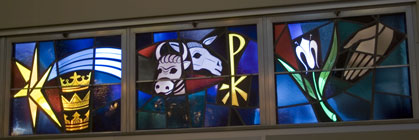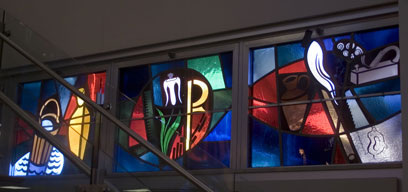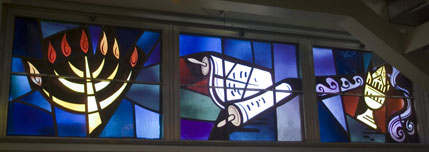Stained Glass Windows
Installed by Maryknoll Seminary
The Learning Resources Center, library and computer lab are located in the former chapel of the Maryknoll Seminary. The Maryknoll Seminary installed 12 main stained glass windows portraying incidents in the life of Christ. Under 10 of these main windows are 3 smaller windows portraying the theme of the main window above them. In addition there are 2 windows near the front of the Learning Resources Center.
The text accompanying the photographic images below was prepared by the former Maryknoll Seminary. Logan College of Chiropractic has provided this text for informational and educational purposes only. Logan College does not guarantee the accuracy, relevance, or completeness of this information. Further, the inclusion of this text is not intended to endorse, recommend, or favor the views of any religion or religious sect. The statements and opinions expressed in the following text are those of the authors and do not necessarily reflect the opinions or beliefs of Logan College of Chiropractic, or its officers, directors or associates.
Scriptural quotations have been taken from the New Testament translation of the original Greek by James A. Kleist and Joseph L. Lilly.
I. ECCE VIRGO CONCIPIET Behold, a Virgin shall conceive The annunciation of the angel to Mary that she was to become the mother of the Savior, Jesus Christ, as foretold by the prophets. The dove is always a symbol of the Holy Spirit. And the angel said to her: "Do not tremble, Mary. You have found favor in the eyes of God. Behold you are to be a mother, and to bear a son, and to call him Jesus! He will be great: 'Son of the Most High' will be his title, and the Lord God will give to him the throne of his father David. He will be king over the house of Jacob forever, and to his kingship there will be no end." Luke 1:30-33 |
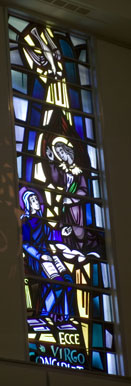 |
II. PUER NATUS EST NOBIS A son is born to us. In this window the birth of Christ in the stable of Bethlehem is depicted. The angel represents the heavenly choir which sang to the shepherds. The lamb represents the stable where animals were sheltered. Because "there was no accommodation for them," Mary and Joseph found shelter in the stable where Christ was born. Accordingly, the people went, each to the city of his ancestor, to be registered; and so Joseph, too, being a member of the house and family of David, went up from the town of Nazareth in Galilee to David's town in Judea, called Bethlehem, in order to be registered. He was accompanied by his espoused wife Mary, who was with child. In the course of their stay there, the time came for her delivery and she gave birth to her first-born son. She wrapped him in swaddling clothes, and laid him in a manger, because there was no accommodation for them in the lodging. Luke 2:3-7 |
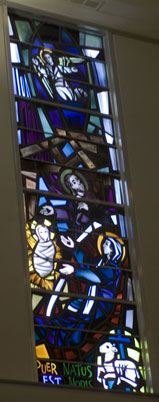 |
III. LUMEN AD REVELATIONEM GENTIUM A light to illumine the Gentiles. The subject of this window is the Epiphany, the adoration of the Magi; the revelation of Christ to the Gentiles. Note the lighted candle which is the symbol of Christ, the light of the world, and the star of Behlehem which guided the Magi.
a. The star of David indicates that the prophets foretold that Christ would be a descendant of David. The star has a comet's tail for it is claimed that a comet was seen in the sky in the Near East about the time of Christ's birth. The three crowns indicate the three Magi who came to adore Christ. b. The ox and the ass indicate the stable. The Chi-Rho is a monogram of Christ. c. The flower represents fruitfulness. At the sight of the star they were supremely happy. And so, entering the house and seeing the child with his mother Mary, they threw themselves down to do homage to him. Opening also their treasure chests, they presented him with gifts: gold, frankincense, and myrrh. Matthew 2:10-12 |
 |
IV. NUNC DIMITTIS SERVUM TUUM Now you may release your bondsman. These were the words of Simeon when Christ was presented in the temple of Jerusalem according to the Jewish law for firstborn sons who were consecrated to God. The subject of the window is the presentation of Christ in the temple. Above: Simeon is holding the Christ-child. Middle: Mary and Joseph are shown with a cage and two doves, the offering made by the poor to redeem the first born son. In the lower right is a table, a plate, and a knife, symbolizing sacrifice.
a. A palm tree represents paradise. b. A heart pierced by a sword symbolizes the prophecy of Simeon that a "sword of sorrow" would pierce Mary's heart. c. Doves in a cage represent the offering of the poor on the consecration of their first born son in the temple of Jerusalem. "Now you may release your bondsman, O Master, according to your promise, in peace! For my eyes have looked upon the salvation which you have prepared for all the nations to behold, a Light to illumine the Gentiles, a Glory to grace your people Israel." Luke 2:29-32 |
 |
V. ERAT SUBDITUS ILLIS He was subject to them. This indicates Christ's obedience to Mary and Joseph during His hidden life at Nazareth. The subject of this window is the hidden life of Christ at Nazareth. Mary is shown spinning to make clothes for the Holy Family. The water jar recalls the duty of the women to carry water from the village spring or well for household uses. Water is also a symbol of eternal life. Joseph is seen instructing the boy Christ in carpentry. The saw, square, axe, and hammer are the tools of the carpenter's trade. The houses represent the village of Nazareth.
a. The wavey lines symbolize water which, together with the jar and the bucket, recall the importance of water to human life. These objects represent how important the imitation of Christ's homely virtues are to the eternal life of mankind. b. The flower blossom indicates the results of family harmony: happiness. The Chi-Rho is still another symbol for Christ. c. The plane and the saw signify the work of Christ and Joseph. The water pitcher and hand spindle for spinning yarn signify the work of the Blessed Mother. He went down in their company and came to Nazareth, where he was subject to them. His mother treasured all these incidents in her memory, and Jesus made steady progress, proportionately to his age, in understanding and in favor with God and men. Luke 3:51-52 |
 |
VI. ZELUS DOMUS TUAE COMEDIT ME The zeal of Thy house has consumed me. This statement, recalling a quotation from the Old Testament, was applied to Christ when He rid the temple of the money changers. By extension, it is also applied to the zeal of Christ as shown when He was twelve years old and found Mary and Joseph in the temple, discussing religious doctrine with the Jewish scholars and priests. The subject is the finding of Jesus in the temple after Mary and Joseph had searched three days for Him. He told them that He must be about His Father's business-- saving the world. The scrolls and books pictured at the bottom represent the Jewish Holy Scriptures -- "The Law and the the Prophets."
a. The seven-branched candlestick represents the Jewish religion. This candlestick was one of the prominent fittings in the temple of Jerusalem. Orthodox Jewish synagogues usually display a seven branched candlestick. It is often used in Catholic symbolism to represent the Seven Sacraments and the seven gifts of the Holy Spirit. b. The scroll represents the Jewish Scripture - the Jewish "Bible". c. The thurible (censer) with smoking incense is a symbol of adoration, worship, and prayer. A sacrifice of incense was offered daily to God in the temple of Jerusalem. His mother said to him: "Child, why did you behave towards us in this way? Oh, our hearts were heavy - your father's and mine - as we searched for you." He said to them: "Why did you search for me? I had to answer my Father's call, and did you not know it?" But they did not grasp the meaning of the reply he made to them. Luke 3:48-50 |
 |
VII QUODCUMQUE DIXERIT VOBIS FACITE No matter what he tells you, be sure you do it. These were the words of Mary to the servants at the wedding feast of Cana. When the host's wine ran out, she asked Christ to do something to avoid embarrassment for the bride and groom. The scene is the occasion of Christ's first miracle, the changing of the water into wine; the first revelation of His divine power of miracles. Also, it suggests Christ's concern about the sanctity of marriage, and His deference to the wish of His beloved mother. In the window we see the bride and groom, Christ, Mary, and the apostles; also, the servant filling the water jar. The whole incident symbolizes the Sacrament of Matrimony, the foundation of the Christian family.
a. Joined hands symbolize the marriage bond. b. The two rings symbolize the union of the two partners. The two lighted candles (which are used at the Catholic marriage ceremony in some places) represent Christ, meaning that He too is a partner in every sacramental marriage by the grace He bestows. c. The water jar indicates the miracle and is a symbol of marriage obligations. When the wine had run short, the mother of Jesus said to him: "They have no wine." Jesus replied: "Leave that to me, mother! My time has not yet come!" His mother then said to the waiters: "No matter what he tells you, be sure you do it." John 2:3-5 |
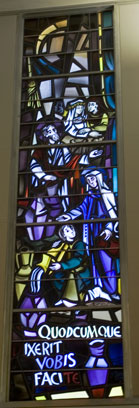 |
VIII VENI, SEQUERE ME Then come back and be my follower. This expressed Christ's invitation to those who would be His apostles. In this window we see the rich young man and Christ. In the upper left hand corner, we note a crown surrounded by a cross - the crown of glory is won only by the cross - self-sacrifice in imitation of Christ. The money bag and coins suggest attachment to worldly wealth. The staff is the symbol of the shepherd and of the apostles. The star indicates the high ideals Christ expects of His apostles.
a. The arm and hand holding the cross represent the priest bringing the salvation of Christ to men. b. There is a double yoke, one large and one small. The large one Christ bears; the small one is for us. We do not bear our yoke alone but with Christ. c. The lamb holding the pennant is a symbol of Christ's victory over death and sin. Christ was called by St. John the Baptist, "The Lamb of God," that is the victim of a sacrifice which would redeem mankind. This symbol is also used to represent Christ's resurrection. Jesus looked at him intently and loved him. Then he said to him: "One thing is still wanting to you: go, sell all you have and give the proceeds to the poor, and you will have an investment in heaven; then come back and be my follower." But he frowned at the words and went away with a heavy heart; for he had much property. Mark 10:21-22 |
 |
IX HOC FACITE IN MEAM COMMEMORATIONEM Do this in commemoration of Me. Christ spoke these words at the Last Supper when He commanded the Apostles to change bread and wine into His Body and Blood. The theme of this window is the Holy Eucharist, sacrifice and sacrament. The Mass being a mystical renewal of Christ's passion, death, and resurrection, the instruments of His suffering are shown. The chalice of bitter suffering is mentioned in the agony in the garden of Getsemane; the sponge of bitter potion was offered Him in His thirst. The stool represents the stool on which He sat when the Roman soldiers reviled Him.
a. The wheat and grapes provide the bread and wine, these in turn become the elements of the Mass as indicated by the hosts and chalice. b. The lamb whose blood is flowing into a chalice represents Christ, the victim of sacrifice whose blood in the chalice of the Mass brings the fruits (redemption) of the shedding of His blood to us in the Mass and Holy Communion. c. The staff and bag are symbols of man's pilgrimage on earth towards heaven. The apostles, said Christ, should go forth without purse or staff, depending only on His assistance. These articles suggest the vocation of the apostle in search of souls. Before supper was over, Jesus took bread into his hands and after saying grace, broke it into portions, which he gve to the disciples with the words: "Take! Eat! This is my body." He also took a cup and, after saying grace, passed it to them with the words: "Drink of it, every one of you; for this is my covenant-blood, which is about to be shed for the sake of many, with a view to forgiveness of sins. Matthew 26:26-29 |
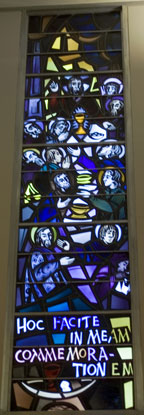 |
X RESURREXIT SICUT DIXIT He has risen as he predicted. The angel spoke these words to the holy women on the first Easter morning. The theme of this window is the Resurrection of Christ from the dead. The window depicts the tomb, the guards.
a. The plant dropping seeds is a symbol of rebirth. The plant may die, but its seeds cause new life to spring up. By His death Christ planted the seeds of our new life. Christ's resurrection is the culmination of our redemption by virtue of which we are able to live a new life in Christ; as in baptism we "are born again." b. Jonah and the big fish are pictured in this window. Christ used the story of Jonah and the big fish as a sign of His forthcoming resurrection from the dead after three days in the tomb. c. The pomegranate with its numerous seeds is a symbol of the resurrection, re-birth: as the seeds burst forth from the fruit, Christ burst from the tomb. But the angel reassured the women. "You have nothing to fear," he said; "I know you are looking for Jesus the Crucified. He is not here. He is risen as he predicted." Matthew 28:5-6 |
 |
XI EUNTES, DOCETE OMNES GENTES Go, therefore, and initiate all nations in discipleship. Just before He ascended into heaven, Christ commissioned His apostles to preach to the entire world. The top portion of the window shows Christ in His glorious body, bearing the wounds in His hands and feet. He is ascending into heaven. The middle portion of the window shows Christ commanding His apostles to go forth to preach. The book represents the Gospel; the dove, the Holy Spirit which Christ promised to send upon His Church to guide it and to keep it from error.
a. The boat is a symbol of the Church, reminding us of the fishing boat of Peter and Christ's promise to make the apostles "fishers of men." The apostles and their successors are called "Fishers of souls." b. The footprints on the mountain top near Jerusalem indicate Christ's ascension. c. The man's face surrounded with a halo of light with the wings was used as a symbol in the early church to suggest heaven, the dwelling place of God. Christ ascended into heaven in His human but glorified body to take His place at the right hand of the Father in glory as the new Adam, the new head of the human race. The wavey lines signify water which is a symbol of eternity. Go, therefore, and initiate all nations in discipleship: baptize them in the name of the Father and of the Son and of the Holy Spirit. Matthew 28:19-20 |
 |
XII REPLETI SUNT OMNES SPIRIO SANCTO They were all filled with the Holy Spirt. This statement is taken from the Acts of the Apostles describing the effects of the descent of the Holy Spirit upon the apostles on the first Pentecost. This window shows the Holy Spirit coming upon the apostles who were assembled in the "upper room" in Jerusalem in the company of Mary and the other disciples. Tongues of fire hover over their heads as described in the passage below, and they were filled with the Holy Spirit. The tongues of fire are also used as symbols of divine charity and zeal.
a. The figure represents a youth receiving the Holy Spirit in the sacrament of Confirmation. b. The diagram of the world indicates the universality of Christ's church. Pentecost is called the birthday of Church. The tongues of fire suggest the Divine Spirit of Truth pervading the world. c. This window shows the basilica of St. Peter's in Rome, the headquarters of the Pope as head of the Church, Christ's vicar on earth. Again the tongues of fire tell us of the presence of the Holy Spirit in the Church, as Christ promised, to the end of time. When the day of Pentecost had come, they were all together in one place. Suddenly there came a sound in the sky, as of a violent wind blowing, and it filled the whole house where they were staying. And there appeared to them tongues like fire which distributed themselves and settled on each of them. They were all filled with the Holy Spirit and began to speak in foreign tongues, as the Holy Spirit prompted them to give utterance. Acts of the Apostles 2:1-4 |
 |
Window across from Circulation Desk 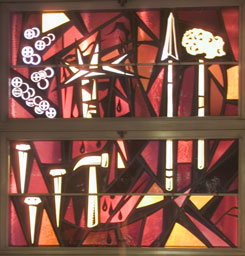
|
|
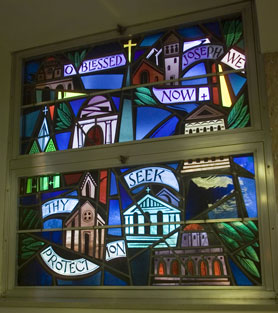 Window behind Circulation Desk This window depicts several churches to indicate that Joseph is venerated as the protector of the worldwide Church. |
|
 Maryknoll Seminary at Chesterfield
Maryknoll Seminary at Chesterfield
